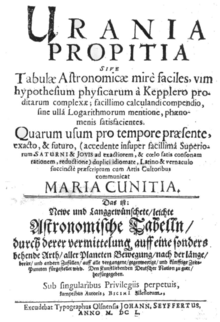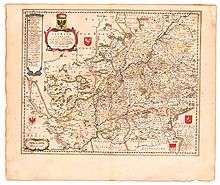Maria Cunitz

Maria Cunitz or Maria Cunitia[1][2] (other versions of surname include: Cunicia, Cunitzin,[3] Kunic, Cunitiae, Kunicia, Kunicka[4]) (Wołów, Silesia, 1610 – Byczyna, Silesia, August 22, 1664) was an accomplished German astronomer, and one of the most notable female astronomers of the modern era. She authored a book Urania propitia, in which she provided new tables, new ephemera, and a more elegant solution to Kepler's problem. The Cunitz crater on Venus is named after her. The minor planet 12624 Mariacunitia is named in her honour.[5]
Life
Maria Cunitz was born in Wohlau (now Wołów, Poland), as the eldest daughter of a Baltic German, Dr. Heinrich Cunitz,[6][7] a physician and landowner who had lived in Schweidnitz for most of his life, and Maria Scholtz from Liegnitz,[8][9] daughter of German scientist Anton von Scholtz[10] (1560–1622), a mathematician and counselor to Duke Joachim Frederick of Liegnitz. The family eventually moved to Schweidnitz in Lower Silesia (today Świdnica, Poland). At an early age Maria married (in 1623) the lawyer David von Gerstmann. After his death in 1626, she married (in 1630) Dr. Elias von Löwen,[11] also from Silesia.[12] Elias and Maria had three sons: Elias Theodor, Anton Heinrich and Franz Ludwig.
Maria's most significant work was composed on the estate of the Cistercian convent in Łubnice under Ołobok near Kalisz, Poland where, with her husband, she had taken refuge at the outbreak of the Thirty Years' War (they were of Protestant religion; her siblings, who stayed in Silesia, converted to Roman Catholicism). After their return to Silesia, they published, at their own expense, Maria's book in 1650. The work was dedicated to Holy Roman emperor Ferdinand III. In 1655, a catastrophic fire of Pitschen[13] (Polish: Byczyna) destroyed their scientific papers, and also the instruments and chemicals used for making many types of medicines. This undercut their source of income. Maria became a widow (a woman whose spouse has died) in 1661, and died at Pitzen in 1664.[11]
The year of Maria's birth is uncertain. No birth, baptism or similar documents have ever been located. The year was speculated about in the first major German-language publication about Maria Cunitz of 1798.[14] Dr. Paul Knötel appears to be the first to give the year 1604 as the year of Maria's birth.[15] This date seemed to make sense since her parents married the previous year. Other authors later appear to have repeated the same year. The proof that Maria was actually born in 1610 is furnished by an anthology with congratulation poems on her first wedding, in connection with a letter of Elias A Leonibus to Johannes Hevelius from the year 1651, found recently by Dr. Ingrid Guentherodt.[16][17]
Accomplishments
The publication of the book Urania propitia (Olse,[18] Silesia, 1650) gained Cunitz a European reputation. She was acclaimed as the most learned woman in astronomy since Hypatia of Alexandria.[19] Significantly for a technical publication of that period, her book was written both in Latin and German (stating that it was to increase the accessibility to her work). Urania propitia was a simplification of the Rudolphine Tables. It provided new tables, new ephemera, and a more elegant solution to Kepler's Problem, which is to determine the position of a planet in its orbit as a function of time. Today, her book is also credited for its contribution to the development of the German scientific language.[20]
Because of her many talents and accomplishments, Cunitz was called the "Silesian Pallas". In his 1727 book Schlesiens Hoch- und Wohlgelehrtes Frauenzimmer, nebst unterschiedenen Poetinnen..., Johan Caspar Eberti wrote[21] that
(Maria) Cunicia or Cunitzin was the daughter of the famous Henrici Cunitii. She was a well-educated woman, like a queen among the Silesian womanhood. She was able to converse in seven languages, German, Italian, French, Polish, Latin, Greek and Hebrew, was an experienced musician and an accomplished painter. She was a dedicated astrologist and especially enjoyed astronomical problems.
Nationality

Maria Cunitz is usually characterized as Silesian, for example in the Encyclopædia Britannica Eleventh Edition of 1911.[11] She was born and spent most of her life in the Holy Roman Empire, which included non-German minorities, ruled by the Austrian Habsburg Monarchy. The fragment of Silesia in which Maria lived was part of Bohemia before 990,[22] the united Poland between 990 [23][24] and 1202[25] and part of Bohemia between 1038 and 1050.[26] In 1202 the Polish seniorate was abolished and all Polish Duchies, including Silesia, became independent,[25] although four Silesian dukes of the 13th century were rulers of Kraków and held the title Duke of Poland.[25][27] In 1331 the region again became part of Bohemia.[28] In 1742 it become part of Prussia and in 1871 the German Empire. About three centuries after Maria's lifetime it was reassigned to Poland after World War II.
During Maria's lifetime, nationality did not play as significant a role in determining person's identity as it does today.[29][30] Nevertheless, multiple later sources felt the need to assign to Maria Cunitz a nationality relevant to their own time. She has mostly been described as German, for example in Bibliographical Dictionary of Woman in Science.[31] She published in German. She has been also described as Polish[4][32][33][34] and some[4] consider her to be the first Polish woman astronomer. Cunitz spoke not only German and Polish but also French, Greek, Italian, Latin and Hebrew.[35]
References
- ↑ Cunitz, Maria. "Urania propitia, sive Tabulæ Astronomicæ mirè faciles, vim hypothesium physicarum à Kepplero proditarum complexae; facillimo calculandi compendio, sine ullâ logarithmorum mentione paenomenis satisfacientes; Quarum usum pro tempore praesente, exacto et futuro succincte praescriptum cum artis cultoribus communicat Maria Cunitia. Das ist: Newe und Langgewünschete, leichte Astronomische Tabelln, etc.", Oels, Silesia,1650.
- ↑ Reproduction of the signature of Maria Cunitia
- ↑ Zedler's Universallexikon, Halle-Leipzig, 1737, Bd. 15, Sp. 2134f, Stichwort: Kunitzin
- 1 2 3 Storm Dunlop, Michèle Gerbaldi, "Stargazers: the contribution of amateurs to astronomy", Springer-Verlag, 1988, pg. 40
- ↑ http://www.cfa.harvard.edu/iau/lists/NumberedMPs010001.html
- ↑ Allgemeines Schriftsteller- und Gelehrten-Lexikon der Provinzen Livland, Esthland und Kurland, Volume 1, J.F. Steffenhagen und Sohn, 1827
- ↑ Sigrid Dienel: Die Pestschrift des schlesischen Arztes Heinrich Cunitz (1580-1629) aus dem Jahr 1625: ein zeitgenössisches medizinisch-pharmazeutisches Dokument? : eine vergleichende Untersuchung mit Pestschriften aus dem 16. und 17. Jahrhundert, 2000
- ↑ Marilyn Bailey Ogilvie, The Biographical Dictionary of Women in Science: Pioneering Lives From Ancient Times to the Mid-20th Century, 2000, page 309.
- ↑ Name Lignitz on the map from that period File:Blaeu 1645 - Nova totius Germaniæ descriptio.jpg
- ↑ Johann Heinrich Zedler, Grosses vollständiges Universal-Lexicon Aller Wissenschafften und Künste, 68 Bände, Leipzig 1732–1754, hier: Band 35, Spalte 1618f.
- 1 2 3 Chisholm 1911.
- ↑ Article „Löwen, Elias von“ in: Allgemeine Deutsche Biographie, herausgegeben von der Historischen Kommission bei der Bayrischen Akademie der Wissenschaften, Band 19 (1884), ab Seite 311, Digitale Volltext-Ausgabe in Wikisource, URL: http://de.wikisource.org/w/index.php?title=ADB:L%C3%B6wen,_Elias_von&oldid=810951 (Version vom 21. August 2009, 02:44 Uhr UTC)
- ↑ Name Pitzen as on Blaeu's 1645 map of Silesia File:Blaeu 1645 - Silesia Ducatus.jpg
- ↑ Johann Ephraim Scheibel: Nachrichten von der Frau von Lewen geb. Cunitzin. In: Astronomische Bibliographie, der 3. Abteilung, zweite Fortsetzung, Schriften aus dem siebzehnten Jahrhundert von 1631 bis 1650 aus der Reihe Einleitung zur mathematischen Bücherkenntnis. Nr. 20, Breslau 1798, pages 361-378.
- ↑ Paul Knötel: Maria Cunitia. In: Friedrich Andreae (Hrsg.): Schlesier des 17. bis 19. Jahrhunderts, Schlesische Lebensbilder. Nr. 3, Breslau 1928, pages 61-65.
- ↑ Ingrid Guentherodt: Maria Cunitia. Urania propitia; Intendiertes, erwartetes und tatsächliches Lesepublikum einer Astronomin des 17. Jh.. In: Daphnis. Zeitschrift für mittlere deutsche Literatur. Nr. 20, 1991, pages 311-353.
- ↑ Ingrid Guentherodt: Frühe Spuren von Maria Cunitia und Daniel Czepko in Schweidnitz 1623. In: Daphnis. Zeitschrift für mittlere deutsche Literatur. Nr. 20, 1991, pages 547-584.
- ↑ Name Olse as on Blaeu's 1645 map of Silesia File:Blaeu 1645 - Silesia Ducatus.jpg
- ↑ Jean Baptiste Joseph Delambre, Histoire de l'astronomie moderne, Tome Second, M. V. Courcier, Libraire pour les sciences, Paris, 1821.
- ↑ Ingrid Güntherodt (Guentherodt), Maria Cunitz und Maria Sibylla Merian: Pionirinnen der Deutsches Wissenschaftssprache im 17. Jahrhundret, Zeitschrift für Germanistische Linguistik, Vol. 14, 1, pp. 23-49, DOI: 10.1515/zfgl.1986.14.1.23, Oct.2009.
- ↑ Johann Caspar Eberti. "Eröffnetes Cabinet dess gelehrten Frauen-Zimmers. Darinnen die berühmtesten dieses Geschlechtes." Iudicium, München 2004, ISBN 3-89129-998-2. (Repr. of Schlesiens Hoch- und Wohlgelehrtes Frauenzimmer, nebst unterschiedenen Poetinnen, so sich durch schöne und artige Poesien bey der curieusen Welt bekandt gemacht, etc, Breslau 1727), pages 25-28.
- ↑ Handbuch der historischen Stätten: Schlesien, 2003, Hubert Weczerka, page XXXI, Stuttgart: Alfred Kröner Verlag, ISBN 3-520-31602-1
- ↑ Handbuch der historischen Stätten: Schlesien, 2003, Hubert Weczerka, page XXXII Stuttgart: Alfred Kröner Verlag, ISBN 3-520-31602-1
- ↑ Dehio - Handbuch der Kunstdenkmäler in Polen: Schlesien, Badstübner, Ernst; Dietmar Popp, Andrzej Tomaszewski, Dethard von Winterfeld, page 1, 2005, München, Deutscher Kunstverlag 2005, ISBN 3-422-03109-X
- 1 2 3 Handbuch der historischen Stätten: Schlesien, 2003, Hubert Weczerka, page XXXV, Stuttgart: Alfred Kröner Verlag, ISBN 3-520-31602-1
- ↑ Handbuch der historischen Stätten: Schlesien, 2003, Hubert Weczerka, page XXXII + XXXIII, Stuttgart: Alfred Kröner Verlag, ISBN 3-520-31602-1
- ↑ (English) Oskar Halecki, Antony Polonsky (1978). A history of Poland. Routledge. pp. :36–37. ISBN 0-7100-8647-4. Google Books
- ↑ Handbuch der historischen Stätten: Schlesien, 2003, Hubert Weczerka, page 128, Stuttgart: Alfred Kröner Verlag, ISBN 3-520-31602-1
- ↑ Smith, Anthony D. (1993). National Identity. Reno: University of Nevada Press. p. 72. ISBN 0-87417-204-7.
- ↑ "The Dynamics of the Policies of Ethnic Cleansing in Silesia in the Nineteenth and Twentieth Centuries" by Tomasz Kamusella, Open Society Institute, Center for Publishing Development, Budapest, Hungary, 1999, http://rss.archives.ceu.hu/archive/00001016/01/17.pdf
- ↑ Marilyn Bailey Ogilvie, Joy Dorothy Harvey, "The Biographical Dictionary of Women in Science: Pioneering Lives from Ancient Times to the Mid-20th Century", Routledge, 2000, pg. 309,
- ↑ https://books.google.com/books?id=S_NJ7AubQIcC&pg=PA28&dq=Maria+Cunitz+Polish+astronomer&lr=&as_brr=0#v=onepage&q=Maria%20Cunitz%20Polish%20astronomer&f=false
- ↑ http://www.szlakcysterski.org/?pokaz=obiekty_cysterskie&id=34&zmien_jezyk=en
- ↑ Margaret Alic, "Hypatia's heritage: a history of women in science from antiquity through the nineteenth century", Beacon Press, 1986, pg. 120
- ↑ https://books.google.com/books?id=P_oRAAAAYAAJ&pg=PA436&dq=Maria+Cunitz+Polish+astronomer&lr=&as_brr=0#v=onepage&q=Maria%20Cunitz%20Polish%20astronomer&f=false
- Attribution
![]() Chisholm, Hugh, ed. (1911). "Cunitz, Maria". Encyclopædia Britannica (11th ed.). Cambridge University Press.
Chisholm, Hugh, ed. (1911). "Cunitz, Maria". Encyclopædia Britannica (11th ed.). Cambridge University Press.
External links
| Wikimedia Commons has media related to Maria Cunitz. |
- Digital-Library of Wroclaw
- Web page on Maria Cunitz at University of Florida
- O'Connor, John J.; Robertson, Edmund F., "Maria Cunitz", MacTutor History of Mathematics archive, University of St Andrews.
- Adolf Schimmelpfennig (1876), "Cunitz, Maria", Allgemeine Deutsche Biographie (ADB) (in German), 4, Leipzig: Duncker & Humblot, p. 641
- Zedler Zedler's Universallexikon, Bd. 15, Sp. 2134f, Stichwort: Kunitzin